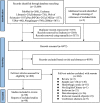Prevalence and risk factors of ischemic stroke-related headache in China: a systematic review and meta-analysis
- PMID: 35953857
- PMCID: PMC9367127
- DOI: 10.1186/s12889-022-13917-z
Prevalence and risk factors of ischemic stroke-related headache in China: a systematic review and meta-analysis
Abstract
Background: Headache accompanying ischemic stroke is considered an independent predictor of neurological deterioration. This meta-analysis aims to estimate the prevalence of ischemic stroke-related headaches and identify its risk factors in China.
Methods: PubMed, Embase, Cochrane Library database, Web of Science, PsycINFO, and four Chinese databases for the related publications were searched. Two researchers independently selected the literature, extracted the relevant data, and assessed its methodological quality. The meta-analysis applied a random-effects model with R software to calculate the pooled prevalence of ischemic stroke-related headaches in Chinese patients, and to merge the odds ratio (OR) of risk factors. Subgroup analysis, sensitivity analysis, and meta-regression analysis were conducted. Publication bias was assessed by a funnel plot and Egger test.
Results: Ninety-eight studies were eligible for inclusion. The overall pooled prevalence of ischemic stroke-related headache was 18.9%. Subgroup analysis showed that the prevalence of ischemic stroke related-headaches was higher among studies using self-report to diagnosis headache (18.9%; 95%CI, 8.9% to 40.2%), and those focused on age ≥ 55 years (19.7%; 95%CI, 14.9% to 25.9%), rural settings (24.9%; 95%CI, 19.7% to 31.6%). There were no significant differences in the headache prevalence between studies in the south and north, and inland and coastal studies. The prevalence of pre onset headache (13.9%) and tension-type headache (15.5%) and was higher compared with other types. History of headache (OR = 3.24; 95%CI, 2.26 to 4.65.), female gender (OR = 2.06; 95%CI, 1.44 to 2.96.), midbrain lesions (OR = 3.56; 95%CI, 1.86 to 6.83.), and posterior circulation stroke (OR = 2.13; 95%CI, 1.14 to 4.32) were major risk factors.
Conclusion: The prevalence of ischemic stroke-associated headache is high in China. In addition, women, presence of midbrain lesions, posterior circulation stroke and a history of migraine were high-risk factors for ischemic stroke-related headaches. Designing effective interventions to prevent or alleviated headaches is necessary to promote patients' neurological recovery and quality of life.
Keywords: Headache; Ischemic stroke; Meta-analysis; Prevalence; Risk factors; Systematic review.
© 2022. The Author(s).
Conflict of interest statement
The authors declare that they have no competing interests.
Figures
Similar articles
-
Prevalence and risk factors of headache in Chinese with stroke: a cross-sectional study based on CHARLS.J Headache Pain. 2024 Dec 18;25(1):217. doi: 10.1186/s10194-024-01930-z. J Headache Pain. 2024. PMID: 39695395 Free PMC article.
-
Headache after ischemic stroke: A systematic review and meta-analysis.Neurology. 2020 Jan 7;94(1):e75-e86. doi: 10.1212/WNL.0000000000008591. Epub 2019 Nov 6. Neurology. 2020. PMID: 31694924 Free PMC article.
-
The epidemiology of headaches among patients with epilepsy: a systematic review and meta-analysis.J Headache Pain. 2020 Jan 10;21(1):3. doi: 10.1186/s10194-020-1074-0. J Headache Pain. 2020. PMID: 31924166 Free PMC article.
-
Headache at onset of first-ever ischemic stroke: Clinical characteristics and predictors.Eur J Neurol. 2021 Mar;28(3):852-860. doi: 10.1111/ene.14684. Epub 2021 Jan 5. Eur J Neurol. 2021. PMID: 33331100
-
The Bidirectional Relationship Between Iron Deficiency Anemia and Chronic Headache Disorders: A Systematic Review and Meta-Analysis.Anemia. 2025 Feb 7;2025:5695022. doi: 10.1155/anem/5695022. eCollection 2025. Anemia. 2025. PMID: 39959849 Free PMC article. Review.
Cited by
-
Prevalence and risk factors of headache in Chinese with stroke: a cross-sectional study based on CHARLS.J Headache Pain. 2024 Dec 18;25(1):217. doi: 10.1186/s10194-024-01930-z. J Headache Pain. 2024. PMID: 39695395 Free PMC article.
-
New management strategies for primary headache disorders: Insights from P4 medicine.Heliyon. 2023 Nov 14;9(11):e22285. doi: 10.1016/j.heliyon.2023.e22285. eCollection 2023 Nov. Heliyon. 2023. PMID: 38053857 Free PMC article. Review.
-
Secondary headaches - red and green flags and their significance for diagnostics.eNeurologicalSci. 2023 Jun 30;32:100473. doi: 10.1016/j.ensci.2023.100473. eCollection 2023 Sep. eNeurologicalSci. 2023. PMID: 37456555 Free PMC article. Review.
References
-
- Naghavi M, Abajobir AA, Abbafati C, Abbas KM, Abd-Allah F, Abera SF, Aboyans V, Adetokunboh O, Ärnlöv J, Afshin A, et al. Global, regional, and national age-sex specific mortality for 264 causes of death, 1980–2016: a systematic analysis for the Global Burden of Disease Study 2016. Lancet. 2017;390(10100):1151–1210. doi: 10.1016/S0140-6736(17)32152-9. - DOI - PMC - PubMed
-
- Chong WFW, Ng LH, R MHH, Koh GCH, Hoenig H, Matchar DB, Yap P, Venketasubramanian N, Tan KB, Ning C, et al. Stroke rehabilitation use and caregiver psychosocial health profiles in singapore: a latent profile transition analysis. J Am Med Dir Assoc. 2021;22(11):2350–57. e2. - PubMed
Publication types
MeSH terms
LinkOut - more resources
Full Text Sources
Medical





